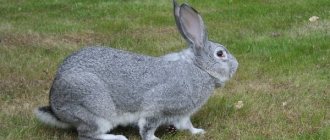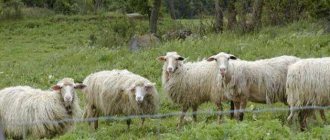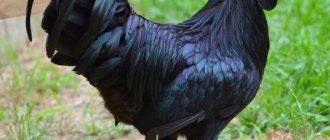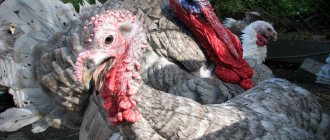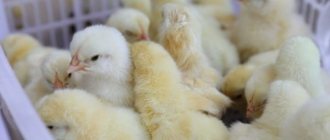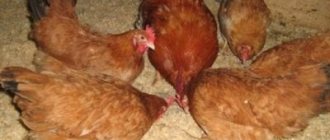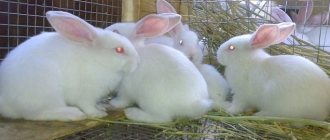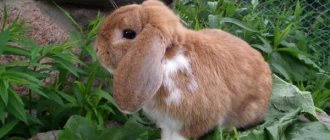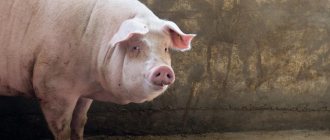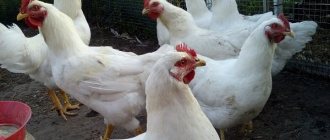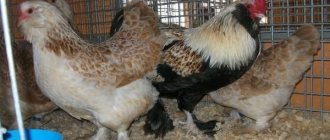The German giant rabbit (Riesen) is one of the most popular breeds of eared animals. Its representatives are valued by breeders and farmers for their good-natured disposition, unpretentiousness, ease of reproduction and large weight. The name translates as “giant” - Risen rabbits can grow up to 14 kg, and the meat of the animals is juicy, dietary and tasty.
History of appearance
Rabbits of the Risen breed appeared in the 15th century in Flanders and were called Belgian giants. It was from then that the first description of the local breed in Flanders was preserved: gray rabbits with thick skins were distinguished by their large weight of almost 5-6 kg.
German scientists worked for a long time to create a new breed. The result was animals of large size with excellent adaptation to different conditions of climatic zones. By the end of the 19th century, they appeared in Germany under a new breed name - German Riesen.
The Risen rabbit was included in the Guinness Book of Records as the largest and fattest representative of the long-eared animals.
The name translates as “giant”, Risen, and speaks of its large size. The oldest species has another name - Flanders. The breed standard was officially registered in 1937 by German breeders, which is how the Belgian giant became German.
General characteristics
Rabbits of the Risen breed are the largest in the world. They have a long body and very well developed muscles. Most often, Risen rabbits are bred for meat and skin, although in rare cases only meat is used.
The description of the breed is quite obvious, so it is very easy to distinguish such rabbits from their counterparts. Their characteristics are as follows:
- The chest circumference, as a rule, reaches 40-42 cm, but it can also be much larger.
- The ears are quite dense, wide, straight. Their length ranges from 17 to 20 cm. Sometimes individuals grow with ears less than 15 cm, which are most often rejected by breeders.
- Paws are straight with highly developed muscles.
- Normal body weight is at least 10 kg. In some cases, rabbits can weigh up to 15 kg.
- The body length is approximately 75 cm.
- The wool is thick, of very good quality, does not exceed 4 cm.
- Colors range from natural hare to blue and black.
The body of German Riesen rabbits most often has the correct proportions, but there are exceptions. The main differences between such animals are the large size of the head, especially the cheek area. In addition, Risen rabbits are quite clumsy and very clumsy, which is why they require large cages.
The meat of this breed is extremely soft and juicy. Unlike most types of rabbits, it does not have the taste and smell of grass, which constantly keeps its demand at a fairly high level.
Rabbits of the Risen breed have a well-developed intellect and a good disposition, thanks to which they can communicate well with their owner. This fact also distinguishes this type of animal from its counterparts.
Risen's character
Despite the agricultural focus of the breed, the calm, slow and good-natured nature of these animals allows owners to communicate well with them. Often, Risen rabbits migrate from the meat type to the category of pets, the size of which is comparable to the average dog.
Risen is one of the few breeds that is not particularly shy and calmly interacts with other pets, dogs and cats. They do not show aggression and are able to play with children. They know their nickname well.
Behavior
The calm and easy-going nature of German Riesens allows them to be kept as pets. There is one more special feature - the animals are quite clumsy and clumsy.
Thanks to their developed intelligence, these animals are able to interact with humans and find a common language with them. Largely for this reason, some people keep giant rabbits in the absence of an intention to sell meat.
Did you know? The interesting rabbit habit of sleeping with its muzzle constantly in motion is not at all accidental. The fact is that an animal, evolutionarily in the rank of prey, must always be on guard. The quivering tip of the nose, the moving mustache are sensors that analyze the safety of the environment even in sleep. As soon as the situation becomes suspicious, the senses send an alarm signal to the brain, and the animal instantly wakes up.
In America, the giant has become widespread as a pet. But it is not recommended to have such an animal for small children. Giants are massive, overweight and can inadvertently harm babies.
Productive qualities
The meat of giants is dietary, soft and juicy.
Highly rated by customers:
- with small children;
- who require high-quality and gentle nutrition;
- athletes who scrupulously monitor their form.
The smooth and warm fur of the Rizens is happily bought by large specialized factories.
Diet
Rabbits need to be fed 2 times a day. The diet must be balanced, since the animal is prone to obesity. Many sources recommend using well water.
This is due to the fact that it is natural, has no chemical impurities and is well absorbed by the animal’s body. If there is no well nearby, drinking, settled water will suffice
The furry kids' favorite dish is vegetable stew!
Despite the usefulness of succulent foods, they are the ones that most often cause difficulties in digestion in rabbits, causing them indigestion or bloating. Hay and grain feeds are more gentle options for the gastrointestinal tract and form the basis of the diet.
Table of product doses absorbed by a five-kilogram rabbit:
When you create your own diet, it is difficult to balance it with vitamins and minerals. But you need to know that most vitamins are produced in the rabbit’s intestines by the bacteria living there, so in the absence of dysbacteriosis, the rabbit almost does not need vitamins.
The table shows the vitamins that are produced in the rabbit’s intestines:
Vaccinations
Animals are allowed to be vaccinated from two months of age. It is better to inject subcutaneously or intravenously. The ideal time for vaccination is spring. The vaccine is given to healthy individuals without signs of disease. Initially, the baby rabbit is vaccinated against VGBV, and after 2 weeks - against myxomatosis. Further, it is recommended to repeat vaccinations against VGBV and myxomatosis. It is important to remember that a break of at least 2 weeks is required between vaccinations.
See also Features of fire rabbits
Care and maintenance
Rabbits of the Risen breed are very thermophilic. Because of this, it is recommended to choose an eastern or southern direction for the cultivation room or place for the construction of cells. The cages in which the eared animals will live should be made 3-4 meters wider than usual due to the size of the rabbit. He can only jump 3 meters and further.
Important! It is strictly forbidden to lift a fluffy by the ears or hind legs, so as not to provoke tendon rupture and even respiratory arrest in a frightened animal.
The most important thing is that the feeder and drinking bowl must always be clean. If a rabbit is born, grows and develops clean, this is a guarantee that in the end you will get tasty and healthy meat, as well as a beautiful skin. When choosing or constructing a cage, preference should be given to natural materials.
It is best to make the cage itself from wood. In this case, it’s not only about naturalness, but also about the safety of the animals, since rabbits can get hurt on metal bars. You can use 2 layers as bedding: sawdust and hay, and fresh hay must be added every day.
The optimal dimensions of a roomy cage are from 1.0 * 0.7 m; for a female rabbit with offspring, these dimensions increase to 1.7 * 1.1 m. The minimum height is from 0.5-0.7 m.
Like other rabbits, they do not tolerate heat well, so in the summer it is better to keep them under a canopy. In case of extreme heat, you can use plastic containers with frozen water.
The Risen rabbit does not tolerate the ammonia smell. Therefore, daily cleaning, disinfection and changing of bedding are mandatory. The air should not stagnate; constant circulation is needed.
Reviews from rabbit breeders
Oksana, 35 years old, Simferopol
I have been breeding these animals for a long time, I like the Risen ones. It’s easy to care for them, and feeding them too. They eat almost everything: greens, apples, carrots, silage and much more. They are gluttonous and do not complain about lack of appetite. You can’t overfeed them, they start to get fat, it’s important to find a middle ground - and there won’t be any problems. I regularly give vitamins and make sure the water is always fresh. I consider the most positive quality of these animals to be their excellent immunity and flexibility.
Oleg, 48 years old, Sochi
The German giants have only one drawback - their enormous size. Such animals are not always comfortable in cages, and it is better to equip enclosures for them, and this requires a lot of space. Otherwise, the rabbits are wonderful, friendly and harmless, their skins are luxurious, and their wool is soft and thick.
Evgenia, 32 years old, Pyatigorsk
Their coat color is very different. I have three black and two gray pets. Their fur is shiny and quite thick. They never froze in winter. But it's not worth the risk. Even in our region, we need not only good ventilation, but also a warm room for the rabbitry.
Breeding
The German Risen is a late-maturing rabbit. If meat breeds can be mated as early as 5 months, then with Risen you will have to wait up to 8-9 months. They select strong individuals from different nests.
For mating, food is removed from the cage so that they are not distracted by food. The rabbit is launched first. If you introduce the female first, she can protect her territory and not allow her partner to approach her. Then the female is placed. Mating lasts about 30 minutes. After the procedure, early pregnancy should begin to be felt within two weeks.
The first signs of pregnancy are the rabbit preparing the nest. She begins to collect hay in one of the corners, plucking down from the chest for a nest. After 15 days, you can try the rabbit's tummy to determine pregnancy, but only very carefully.
If rabbit breeders help a female rabbit during childbirth, then it is imperative to remove the human smell. Otherwise, the female may abandon her babies. The offspring will have to be raised independently.
When the female becomes pregnant, she begins to prepare the nest. The Risen rabbit collects hay and fluff, dragging it to the corner of the cage. Then it is better to transplant the female into a separate cage: half a meter larger. In the new home of the rabbit, you need to place a wide box with high sides for future rabbits.
8 - 12 rabbits are born. The Risen rabbit is a good and caring mother. After giving birth, the female and small rabbits are in the same cage. The babies usually sleep in a box in the corner of the cage, and the mother rests on hay or sawdust, except for periods when she needs to feed them.
The expectant mother should not consume too much food, otherwise overeating will cause obesity and, as a result, difficult childbirth. During the feeding period, the female is given steamed potatoes and plenty of drink.
Potatoes improve the quality and increase the quantity of milk. The female is fed intensively, but without excessive enthusiasm. Only after a week do the rabbits switch to independent feeding.
Repeated insemination is recommended after a month.
Possible diseases
Risen, like all rabbits, are prone to common infectious diseases - myxomatosis and viral hemorrhagic disease of rabbits.
But other pathologies also occur.
Coccidosis
This is an invasive disease that occurs due to poor nutrition and poor care. Coccids remain in excrement for up to 4 months and are capable of destroying an entire nest in a short time, decomposing the gastrointestinal tract and liver of rabbits.
Pasteurellosis
It is transmitted from infected animals, through larvae and bites of blood-sucking insects, clothing and hands of caring people. Rabbits die the fastest, as the virus instantly spreads through the blood and lymph, causing a destructive fever.
In adult animals, the disease proceeds more calmly; ulcers and inflammations form on the body, which gradually open.
Read more in the article about pasteurellosis.
Infectious stomatitis
This disease has mild and severe forms. In the first case, the animals develop profuse salivation, which usually goes away on its own within 14 days.
In severe cases, numerous sores appear in the mouth, which are very painful and prevent the rabbit from eating.
Rhinitis
These are colds that inevitably occur if rabbit hutches are in a draft or not heated enough in winter. In addition, rhinitis can occur from dirty hay areas.
Usually, runny noses quickly go away on their own when living conditions improve, but chronic forms often develop into pneumonia.
Advantages and disadvantages of the breed
Pros:
- The meat of rabbits of this breed is more juicy, soft and tasty, and does not smell like grass. Restaurant menus in Germany especially highlight dishes made from the meat of such animals.
- High percentage of slaughter yield;
- Good quality skins
- Good performance.
- Females are excellent mothers
- Babies need breast milk only in the first week of life.
Minuses:
- They grow up to a year, unlike conventional breeds (3-4 months is enough). Therefore, they consume a lot of food;
- females can mate only from 8 months of age;
- due to a sedentary lifestyle, they are prone to obesity;
- they require large cages.
How to choose a healthy rabbit?
To choose a healthy Risen pet, it is better to use the services of breeding farms. There you can trace the pedigree of the animal. A rabbit born from February to April will be the hardiest and most suitable for breeding. The age that is best when purchasing a Risen for breeding varies between 3-4 months. Experts do not recommend purchasing adult specimens.
It is important to carefully examine the animal to make sure that the pet is healthy. A normal, healthy animal is characterized by mobility and fatness, which should be learned to distinguish from obesity. The back is straight, the paws are even. In the eyes of a healthy Risen rabbit there is clarity, purity, and movement. The fur is without ruffles or bald patches. It is important to pay attention to the inside of the animal’s ears - the presence of wounds and other signs of disease is unacceptable. A normal and healthy animal has an increased appetite. Risen females have a wide pelvis.
Where can I buy?
Only in a breeding farm, where they can show their parents, will they be given the opportunity to choose healthy, well-fed, active and good-natured rabbits no older than 5 months. Here you will be advised on how to properly place your pets, how to care for them, and what to feed them. And one more plus - they will always help you with advice if you are alarmed by something in the behavior of rabbits, because the owners of Rizens always try to be in touch with each other in order to exchange both young animals and news.
For breeding, be sure to take females and males from different nests, so as not to be disappointed in this amazing German Giant breed.
Can it be kept in cages?
Most often, therefore, farmers use the aviary keeping technique for German Risen rabbits. In the photo on this page you can see how large this breed can grow. Of course, they need a lot of space for normal development.
Of course, if necessary, you can breed German Giant Risen rabbits in cages. However, most farmers still consider the use of such a technique for this breed inappropriate. The initial costs of using such technology, unfortunately, can be quite large. After all, Rizens need cages 1.5-2 times larger than for ordinary rabbits. And such agricultural equipment is very expensive.
